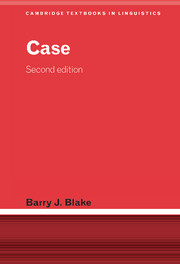Book contents
- Frontmatter
- Contents
- List of figures
- List of tables
- Preface to the Second Edition
- Preface to the First Edition
- List of abbreviations
- 1 Overview
- 2 Problems in describing case systems
- 3 Modern approaches to case
- 4 Distribution of case marking
- 5 Survey of case marking
- 6 Life cycle of case systems
- Notes
- Guide to terminology
- Guide to further reading
- References
- Author index
- Language index
- Subject index
Preface to the First Edition
Published online by Cambridge University Press: 05 June 2012
- Frontmatter
- Contents
- List of figures
- List of tables
- Preface to the Second Edition
- Preface to the First Edition
- List of abbreviations
- 1 Overview
- 2 Problems in describing case systems
- 3 Modern approaches to case
- 4 Distribution of case marking
- 5 Survey of case marking
- 6 Life cycle of case systems
- Notes
- Guide to terminology
- Guide to further reading
- References
- Author index
- Language index
- Subject index
Summary
I can remember my first encounter with case quite clearly. It was in 1949. The language was Latin and the book was Latin for today. The first sentence was Discipulī, pictūram spectāte and it came with a translation ‘Pupils, look at the illustration.’ I cannot say that I quickly became enamoured of case. There was not much pleasure to be had in memorising paradigms, but eventually there were rewards: the rolling hexameters of Virgil, the cleverly contrived odes of Horace and the epigrammatic prose of Tacitus, all exploiting the genius of a highly inflected language, a language where grammatical functions were expressed in the most highly condensed fashion, a single short suffix on a noun expressing case, number and sometimes gender, a single suffix on a verb expressing tense, aspect, mood, voice and the person and number of the subject.
There were other minor encounters with the language of Beowulf and the language of Njal, but my next significant encounter with case came in 1966. In that year I took up a fellowship to study Australian Aboriginal languages and I was sent to western Queensland to record Kalkatungu, or Kalkadoon in the more familiar spelling, a language which at that time had no more than a dozen fluent speakers. Like most Australian languages Kalkatungu had a well-developed case system. For Kalkatungu there was no available grammar and therefore no paradigms to learn. The paradigms had to be built up by a mixture of elicitation and recording of discourse.
- Type
- Chapter
- Information
- Case , pp. xv - xviiPublisher: Cambridge University PressPrint publication year: 2001

